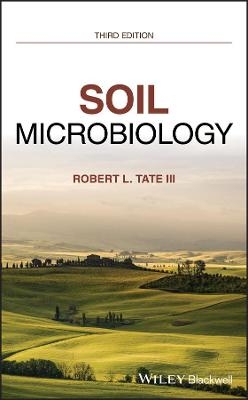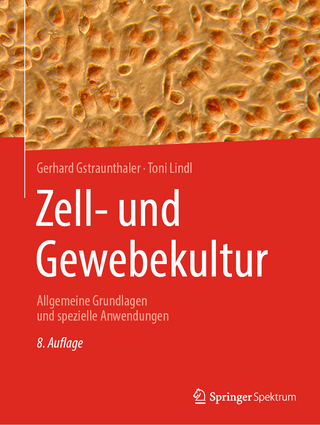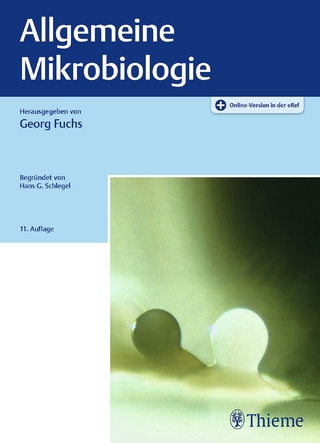
Soil Microbiology
Wiley-Blackwell (Verlag)
978-0-470-31110-3 (ISBN)
An updated text exploring the properties of the soil microbial community
Today, the environmentally oriented specialties of microbiology are shifting from considering a single or a few microbial species to focusing on the entire microbial community and its interactions. The third edition of Soil Microbiology has been fully revised and updated to reflect this change, with a new focus on microbial communities and how they impact global ecology.
The third edition still provides thorough coverage of basic soil microbiology principles, yet the textbook also expands students' understanding of the role the soil microbial community plays in global environmental health and human health. They can also learn more about the techniques used to conduct analysis at this level.
Readers will benefit from the edition's expanded use of figures and tables as well as the recommendations for further reading found within each chapter.
Considers the impact of environmental perturbations on microbial community structure as well as the implications for soil system functions
Discusses the impact of soil microbial communities on food and health related issues
Emphasizes the importance of soil microbial communities on the sustainability of terrestrial ecosystems and solutions to global issues
This third edition is a suitable text for those studying soil microbiology and soil ecology at the undergraduate or graduate level. It also serves as a valuable reference tool for professionals working in the fields of reclamation and soil management.
DR. TATE is Professor Emeritus at Rutgers University and held appointments in the Department of Environmental Sciences and the Environmental and Occupational Health Sciences Institute. The author conducted research at the leading edge of soil microbiology and taught soil microbiology and related courses. He is a fellow of the two leading scientific societies serving soil microbiologists (Soil Science Society of America, Agronomy Society). Dr. Tate served as the Editor-in-Chief of Soil Science and editor of the Journal of the Soil Science Society of America. At Rutgers, he was the Director of the undergraduate Environmental Science Program and Chair of the Department of Environmental Sciences.
Preface xv
Introduction 1
1 Soil Ecosystems: Physical and Chemical Boundaries 5
1.1 Soil as an Ecosystem 11
1.1.1 Soil System Function 12
1.1.2 Soil Formation and the Microbial Community 15
1.1.3 Implications of Definition of the Soil Ecosystem 18
1.2 The Micro-ecosystem 19
1.2.1 Interaction of Individual Soil Components with the Biotic System 19
1.2.2 Aboveground and Belowground Communities and Soil Ecosystem Synergistic Development 31
1.3 The Macro-ecosystem 37
1.4 Concluding Comments 39
2 The Soil Ecosystem: Biological Participants 45
2.1 The Living Soil Component 45
2.1.1 Biological and Genetic Implications of Occurrence of Living Cells in Soil 46
2.1.2 Implications of Microbial Properties for Handling of Soil Samples 55
2.2 Measurement of Soil Microbial Biomass 56
2.2.1 Direct Counting Methods 58
2.2.2 ATP Measure of Soil Microbial Biomass 59
2.2.3 Soil Aerobic Respiration Measurements 60
2.2.4 Chloroform Fumigation (Extraction and Incubation) Technique 61
2.2.5 Limitations of Microbial Biomass Measurements 64
2.3 The Nature of Soil Inhabitants 65
2.4 Autecology and Soil Microbiology 66
2.4.1 Limitations to Autecological Research 67
2.4.2 Autecological Methods 67
2.4.3 PCR for Quantification of Soil Microbes 72
2.4.4 Expression of Population Density per Unit of Soil 78
2.4.5 Products of Soil Autecological Research 78
2.5 Principles and Products of Synecological Research 79
2.6 Interphase Between Study of Individual and Community Microbiology 80
2.7 Concluding Comments 81
3 Microbial Diversity of Soil Ecosystems 89
3.1 Classical Culture-Based Studies of Soil Microbial Diversity 90
3.1.1 Value of Culture-Based Studies of Soil Microbial Diversity 90
3.1.2 Limitations of Culture-Based Studies of Soil Microbial Diversity 90
3.1.3 The Challenge of Defining Bacterial Species 91
3.1.4 Alternatives to Bacterial Strain Isolation 92
3.2 Surrogate Measures of Soil Microbial Diversity 92
3.3 Diversity Surrogates: Physiological Profiling 93
3.3.1 Physiological Profiling of Isolates 93
3.3.2 Community-Level Physiological Profiling 94
3.3.3 Value of Community-Level Physiological Profiling 95
3.3.4 Limitations of Community Level Physiological Profiling 95
3.4 Diversity Surrogates: Phospholipid Fatty Acid Analysis 96
3.4.1 PLFA Analysis of Isolates 96
3.4.2 Community PLFA Analysis 97
3.4.3 Value of PLFA Analysis 98
3.4.4 Limitations of PFLA Analysis 98
3.5 Nucleic Acid-Based Analyses of Soil Microbial Diversity 98
3.5.1 Nucleic Acid Based Analysis of Isolates 99
3.5.2 Community Nucleic Acid Analysis 99
3.5.3 DNA Extraction 100
3.5.4 Analysis of Community DNA 101
3.6 PCR-Based Methods 101
3.6.1 Clone Library Sequencing 101
3.6.2 DNA-Based Fingerprinting Techniques 102
3.6.3 High-Throughput Amplicon Sequencing 103
3.6.4 Limitations of PCR-Based Methods 105
3.7 Metagenomics 105
3.7.1 Limitations of Metagenomics 106
3.8 Conclusions: Utility and Limitations of Diversity Analysis Procedures 107
4 Energy Transformations Supporting Growth and Survival of Soil Microbes 115
4.1 Microbial Growth Kinetics in Soil 116
4.2 Microbial Growth Phases: Laboratory-Observed Microbial Growth Compared to Soil Population Dynamics 120
4.3 Mathematical Representation of Soil Microbial Growth 126
4.4 Uncoupling Energy Production from Microbial Biomass Synthesis 130
4.5 Implications of Microbial Energy and Carbon Transformation Capacities for Soil Biological Processes 132
4.5.1 Energy Acquisition in Soil Ecosystems 132
4.5.2 Microbial Contribution to Soil Energy and Carbon Transformation 136
4.6 Concluding Comments 143
5 Process Control in Soil 149
5.1 Microbial Response to Abiotic Limitations: General Considerations 151
5.1.1 Definition of Limitations to Biological Activity 151
5.1.2 Elucidation of Limiting Factors in Soil 153
5.2 Impact of Individual Soil Properties on Microbial Activity 157
5.2.1 Availability of Nutrients 158
5.2.2 Soil Water 164
5.2.3 Aeration 172
5.2.4 Redox Potential 173
5.2.5 pH 175
5.2.6 Temperature 178
5.3 Microbial Adaptation to Abiotic Stress 180
5.4 Concluding Comments 181
6 Soil Enzymes: Basic Principles and Their Applications 185
6.1 A Philosophical Basis for the Study of Soil Enzymes 187
6.2 Basic Soil Enzyme Properties 192
6.3 Principles of Enzyme Assays 196
6.4 Enzyme Kinetics 202
6.5 Distribution of Enzymes in Soil Organic Components 206
6.6 Ecology of Extracellular Enzymes 210
6.7 Concluding Comments 212
7 Microbial Interactions and Community Development and Resilience 217
7.1 Common Concepts of Microbial Community Interaction 220
7.2 Classes of Biological Interactions 222
7.2.1 Neutralism 223
7.2.2 Positive Biological Interactions 223
7.2.3 Negative Biological Interactions 227
7.3 Trophic Interactions and Nutrient Cycling 235
7.3.1 Soil Flora and Fauna 235
7.3.2 Earthworms: Mediators of Multilevel Mutualism 238
7.4 Importance of Microbial Interactions to Overall Biological Community Development 239
7.5 Management of Soil Microbial Populations 241
7.6 Concluding Comments: Implications of Soil Microbial Interactions 242
8 The Rhizosphere/Mycorrhizosphere 251
8.1 The Rhizosphere 252
8.1.1 The Microbial Community 254
8.1.2 Sampling Rhizosphere Soil 256
8.1.3 Plant Contributions to the Rhizosphere Ecosystem 258
8.1.4 Benefits to Plants Resulting from Rhizosphere Populations 263
8.1.5 Plant Pathogens in the Rhizosphere 264
8.1.6 Manipulation of Rhizosphere Populations 265
8.2 Mycorrhizal Associations 268
8.2.1 Mycorrhizae in the Soil Community 271
8.2.2 Symbiont Benefits from Mycorrhizal Development 273
8.2.3 Environmental Considerations 275
8.3 The Mycorrhizosphere 276
8.4 Conclusion 278
9 Introduction to the Biogeochemical Cycles 287
9.1 Introduction to Conceptual and Mathematical Models of Biogeochemical Cycles 289
9.1.1 Development and Utility of Conceptual Models 290
9.1.2 Mathematical Modeling of Biogeochemical Cycles 295
9.2 Specific Models of Biogeochemical Cycles and Their Application 297
9.2.1 The Environmental Connection 300
9.2.2 Interconnectedness of Biogeochemical Cycle Processes 302
9.3 Biogeochemical Cycles as Sources of Plant Nutrients for Ecosystem Sustenance 306
9.4 General Processes and Participants in Biogeochemical Cycles 307
9.5 Measurement of Biogeochemical Processes: What Data Are Useful? 309
9.5.1 Assessment of Biological Activities Associated with Biogeochemical Cycling 309
9.5.2 Soil Sampling Aspects of Assessment of Biogeochemical Cycling Rates 310
9.5.3 Environmental Impact of Nutrient Cycles 311
9.5.4 Example of Complications in Assessing Soil Nutrient Cycling: Nitrogen Mineralization 312
9.6 Conclusions 315
10 The Carbon Cycle 321
10.1 Environmental Implications of the Soil Carbon Cycle 323
10.1.1 Soils as a Source or Sink for Carbon Dioxide and Methane 324
10.1.2 Diffusion of Soil Carbon Dioxide to the Atmosphere 325
10.1.3 Managing Soils to Augment Organic Matter Contents 327
10.1.4 Carbon Recycling in Soil Systems 328
10.2 Biochemical Aspects of the Soil Carbon Cycle 329
10.2.1 Individual Components of Soil Organic Carbon Pools 330
10.2.2 Analysis of Soil Organic Carbon Fractions 337
10.2.3 Structural versus Functional Analysis 339
10.2.4 Microbial Mediators of Soil Carbon Cycle Processes 342
10.3 Kinetics of Soil Carbon Transformations 344
10.4 Conclusions: Management of the Soil Carbon Cycle 348
11 The Nitrogen Cycle: Mineralization, Immobilization, and Nitrification 355
11.1 Nitrogen Mineralization 359
11.1.1 Soil Organic Nitrogen Resources 359
11.1.2 Assessment of Nitrogen Mineralization 361
11.2 Nitrogen Immobilization 362
11.2.1 Process Definition and Organisms Involved 362
11.2.2 Impact of Nitrogen Immobilization Processes on Plant Communities 362
11.2.3 Measurement of Soil Nitrogen Immobilization Rates 365
11.3 Quantitative Description of Nitrogen Mineralization Kinetics 366
11.4 Microbiology of Mineralization 370
11.5 Environmental Influences on Nitrogen Mineralization 370
11.6 Nitrification 372
11.6.1 Identity of Bacterial Species that Nitrify 373
11.6.2 Benefits to the Microorganism from Nitrification 374
11.6.3 Quantification of Nitrifiers in Soil Samples 374
11.6.4 Discrepancies between Population Enumeration Data and Field Nitrification Rates 376
11.6.5 Sources of Ammonium and Nitrite for Nitrifiers 377
11.6.6 Environmental Properties Limiting Nitrification 377
11.7 Concluding Observations: Control of the Internal Soil Nitrogen Cycle 381
12 Nitrogen Fixation: The Gateway to Soil Nitrogen Cycling 389
12.1 Biochemistry of Nitrogen Fixation 391
12.1.1 The Process 391
12.1.2 The Enzyme, Nitrogenase 394
12.1.3 Measurement of Biological Nitrogen Fixation in Culture and in the Field 396
12.2 General Properties of Soil Diazotrophs 401
12.2.1 Free-Living Diazotrophs 401
12.2.2 Examples of Function of Nonsymbiotic Diazotrophs in Soil Ecosystems 404
12.2.3 Diazotrophs in Rhizosphere Populations 404
12.2.4 Dizaotrophs in Flooded Ecosystems 408
12.3 Conclusions 409
13 Biological Nitrogen Fixation 415
13.1 Rhizobium–Legume Symbioses 416
13.1.1 Grouping of Rhizobial Strains 416
13.1.2 Rhizobial Contributions to Nitrogen Fixation 418
13.1.3 Nodulation of Legumes 419
13.1.4 Plant Control of Nodule Formation 423
13.2 Manipulation of Rhizobium–Legume Symbioses for Ecosystem Management 424
13.3 Rhizobial Inoculation Procedures 426
13.3.1 Inocula Delivery Systems 426
13.3.2 Survival of Rhizobial Inocula 427
13.3.3 Biological Interactions in Legume Nodulation 432
13.4 Nodule Occupants: Indigenous vs Foreign 432
13.5 Actinorhizal Associations 434
13.6 Conclusions 436
14 Denitrification 447
14.1 Pathways for Biological Reduction of Soil Nitrate 448
14.2 Biochemical Properties of Denitrification 450
14.2.1 Carbon and Energy Sources for Denitrifiers 450
14.2.2 Induction of Synthesis of Nitrogen Oxide Reductases 451
14.3 Environmental Implications of Nitrous Oxide Formation 452
14.4 Microbiology of Denitrification 453
14.4.1 Assessment of Soil Denitrifier Populations 453
14.4.2 General Traits of Denitrifiers 454
14.4.3 Generic Identity of Denitrifiers 455
14.5 Quantification of Nitrogen Losses from an Ecosystem via Denitrification 456
14.5.1 Nitrogen Balance Studies 456
14.5.2 Use of Nitrogen Isotopes to Trace Soil Nitrogen Transformations 458
14.5.3 Soil Nitrogen Oxide Transformations 459
14.5.4 Acetylene Block Method for Assessing Denitrification Processes in Soil 460
14.6 Environmental Factors Controlling Denitrification Rates 462
14.6.1 Nature and Amount of Organic Matter 462
14.6.2 Nitrate Concentration 464
14.6.3 Aeration/Moisture 464
14.6.4 pH 465
14.6.5 Temperature 466
14.6.6 Interaction of Limitations to Denitrification in Soil Systems 467
14.7 Conclusions 467
15 Fundamentals of the Sulfur, Phosphorus, and Mineral Cycles 477
15.1 Sulfur in the Soil Ecosystem 477
15.2 Biogeochemical Cycling of Sulfur in Soil 479
15.3 Biological Sulfur Oxidation 482
15.3.1 Microbiology of Sulfur Oxidation 482
15.3.2 Environmental Conditions Affecting Sulfur Oxidation 486
15.4 Biological Sulfur Reduction 488
15.4.1 Anaerobic Biodegradation 490
15.4.2 Reducing Acidity of Acid Mine Drainage 490
15.4.3 Reduction of Complications of Metal Contamination in Soil 490
15.5 Mineralization and Assimilation of Sulfurous Substances 491
15.6 The Phosphorus Cycle 492
15.7 Microbially Catalyzed Soil Metal Cycling 494
15.7.1 Interactions of Soil Metals with Living Systems 495
15.7.2 Microbial Response to Elevated Metal Loading 497
15.7.3 Microbial Modifications of Metal Mobility in Soils 498
15.7.4 Managing Soils Contaminated with Toxic Metals 501
15.8 Conclusion 502
16 Soil Microbes: Optimizers of Soil System Sustainability and Reparation of Damaged Soils 511
16.1 Foundational Concepts of Bioremediation 514
16.1.1 Bioremediation Defined 514
16.1.2 Conceptual Unity of Bioremediation Science 515
16.1.3 Complexity of Remediation Questions 516
16.2 The Microbiology of Bioremediation 517
16.2.1 Microbes as Soil Remediators 518
16.2.2 Substrate–Decomposer Interactions 519
16.2.3 Microbial Inoculation for Bioremediation 528
16.3 Soil Properties Controlling Bioremediation 532
16.3.1 Physical and Chemical Delimiters of Biological Activities 532
16.3.2 Sequestration and Sorption Limitations to Bioavailability 536
16.4 Concluding Observations 538
Concluding Challenge 545
Index 549
| Erscheint lt. Verlag | 24.11.2020 |
|---|---|
| Zusatzinfo | Photos: 10 B&W, 0 Color; Drawings: 50 B&W, 0 Color; Tables: 15 B&W, 0 Color |
| Verlagsort | Hoboken |
| Sprache | englisch |
| Maße | 158 x 231 mm |
| Gewicht | 1021 g |
| Themenwelt | Naturwissenschaften ► Biologie ► Mikrobiologie / Immunologie |
| Naturwissenschaften ► Biologie ► Ökologie / Naturschutz | |
| Naturwissenschaften ► Geowissenschaften ► Geologie | |
| ISBN-10 | 0-470-31110-X / 047031110X |
| ISBN-13 | 978-0-470-31110-3 / 9780470311103 |
| Zustand | Neuware |
| Informationen gemäß Produktsicherheitsverordnung (GPSR) | |
| Haben Sie eine Frage zum Produkt? |
aus dem Bereich


